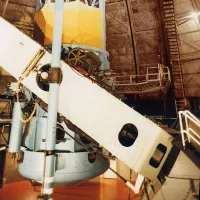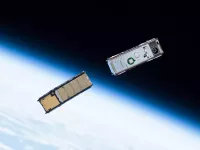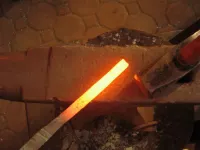The Sun, the star at the center of our Solar System, is a near-perfect sphere of hot plasma. Its core undergoes nuclear fusion, releasing energy primarily as visible light and infrared radiation, with a smaller portion as ultraviolet. It's the primary energy source for life on Earth and has been revered across cultures. The Sun has also been a key focus of astronomical study since ancient times.
1904: Rutherford suggests radioactive decay as the Sun's heat source
In 1904, Ernest Rutherford suggested that the Sun's energy output could be maintained by an internal heat source, proposing radioactive decay as the mechanism.
1920: Eddington proposes nuclear fusion in the Sun
In 1920, Sir Arthur Eddington proposed that nuclear fusion reactions, merging hydrogen into helium nuclei, could occur at the core of the Sun due to extreme pressures and temperatures, producing energy from the net change in mass.
1925: Payne confirms the abundance of hydrogen in the Sun
In 1925, Cecilia Payne confirmed the preponderance of hydrogen in the Sun using the ionization theory developed by Meghnad Saha.
1957: Burbidge, Burbidge, Fowler, and Hoyle explain elemental synthesis in stars
In 1957, Margaret Burbidge, Geoffrey Burbidge, William Fowler, and Fred Hoyle demonstrated that most elements in the universe are synthesized by nuclear reactions within stars, including stars like the Sun.
1959: Launch of Pioneer 6
In 1959, NASA launched Pioneer 6, the first satellite designed for long term observation of the Sun from interplanetary space.
1968: Launch of Pioneer 9
In 1968, NASA launched Pioneer 9, designed for long term observation of the Sun from interplanetary space.
1980: Launch of the Solar Maximum Mission probes by NASA
In 1980, NASA launched the Solar Maximum Mission probes, designed to observe gamma rays, X-rays, and ultraviolet radiation from solar flares during a period of high solar activity.
May 1983: Pioneer 9 ceases data transmission
In May 1983, Pioneer 9, one of the first satellites designed for long-term solar observation, ceased transmitting data after a prolonged period of operation.
1984: STS-41-C retrieves and repairs the Solar Maximum Mission satellite
In 1984, Space Shuttle Challenger mission STS-41-C retrieved the Solar Maximum Mission satellite and repaired its electronics before re-releasing it into orbit.
June 1989: Solar Maximum Mission re-enters Earth's atmosphere
In June 1989, the Solar Maximum Mission, after being repaired in orbit and acquiring thousands of images of the solar corona, re-entered Earth's atmosphere.
1990: Launch of the Ulysses probe to study the Sun's polar regions
In 1990, the Ulysses probe was launched to study the Sun's polar regions, traveling to Jupiter for a "slingshot" maneuver to achieve an orbit far above the ecliptic plane.
1991: Launch of Japan's Yohkoh satellite
In 1991, Japan launched the Yohkoh (Sunbeam) satellite to observe solar flares at X-ray wavelengths, revealing new insights into the corona's dynamics.
December 1995: Launch of the Solar and Heliospheric Observatory (SOHO)
On December 2, 1995, the Solar and Heliospheric Observatory (SOHO), a joint project between the European Space Agency and NASA, was launched to provide a constant view of the Sun from the Lagrangian point between Earth and the Sun.
2001: Yohkoh satellite enters standby mode
In 2001, the Yohkoh satellite went into standby mode after an annular eclipse caused it to lose its lock on the Sun.
2001: Discovery of neutrino oscillation resolves neutrino discrepancy
In 2001, the discovery of neutrino oscillation resolved the discrepancy in the number of electron neutrinos produced in the Sun versus theoretical predictions. It was found that the Sun emits the predicted number of electron neutrinos, but detectors missed approximately 2/3 of them because the neutrinos changed flavor by the time they were detected.
December 2004: Voyager 1 passes through a shock front
In December 2004, the Voyager 1 probe passed through a shock front believed to be part of the heliopause, marking a significant step in its journey towards interstellar space.
2005: Yohkoh satellite destroyed by atmospheric re-entry
In 2005, the Yohkoh satellite was destroyed by atmospheric re-entry.
2008: Prediction of Earth's orbital evolution during Sun's red giant phase
A 2008 article predicted that Earth's orbit will initially expand to at most 1.5 AU due to the Sun's mass loss. However, the orbit will then shrink due to tidal forces, eventually leading to Earth being engulfed by the Sun during the tip of the red-giant branch phase.
August 2012: Voyager 1 enters interstellar medium
On August 25, 2012, Voyager 1 officially entered the interstellar medium at approximately 122 astronomical units (18 Tm) from the Sun. This was confirmed by a marked increase in cosmic ray collisions and a sharp drop in lower energy particles from the solar wind, as recorded by Voyager 1 in late 2012.
2016: Discovery of Proxima Centauri b
In 2016, a potentially habitable exoplanet named Proxima Centauri b, the closest confirmed exoplanet to the Sun, was found orbiting Proxima Centauri.
April 2021: Parker Solar Probe crosses the Alfvén critical surface
In April 2021, the Parker Solar Probe crossed the Alfvén critical surface for the first time at heliocentric distances ranging from 16 to 20 solar radii. This surface defines the boundary where the solar wind transitions from sub-Alfvénic to super-Alfvénic flows.
2022: ESA's Gaia mission predicts Sun's hottest point at 8 billion year mark
In 2022, the ESA's Gaia space observatory mission predicted that the Sun will be at its hottest point at the 8 billion year mark of its life cycle.
2024: SOHO remains in operation
As of 2024, the Solar and Heliospheric Observatory (SOHO) remains in operation, providing a constant view of the Sun and enabling the discovery of numerous comets.
Mentioned in this timeline
NASA the National Aeronautics and Space Administration is an independent...
Japan is an East Asian island country situated in the...

A telescope is an instrument used to observe distant objects...

Earth the third planet from the Sun is unique in...

Satellites often spacecraft are objects intentionally placed into orbit around...

Heat in thermodynamics is defined as energy transferred between a...
Trending
1 month ago Volaris Faces Pilot Dispute: ASPA Challenges Foreign Pilot Hiring Amid Route Revocation

2 months ago Ethan Hawke stars in 'Blue Moon,' a Broadway depiction by Richard Linklater.

5 months ago Kyrie Irving Claims Bill Gates Owns Most US Land and Water, Calls It Weird

5 months ago Ormond Seeks Ovitz Testimony in CAA/Weinstein Lawsuit After Missed Deposition,Enforcement Requested.

9 months ago Max Christie's Connection to Doug Christie Explored Amid Mavericks' Winning Streak.

8 months ago Doug Christie Hired as Sacramento Kings Head Coach with Multiyear Contract
Popular

Stranger Things created by the Duffer Brothers is a popular...

XXXTentacion born Jahseh Dwayne Ricardo Onfroy was a controversial yet...

Kelsey Grammer is an accomplished American actor producer and singer...

Candace Owens is an American conservative political commentator and author...

Bernie Sanders is a prominent American politician currently serving as...
Matt and Ross Duffer known as the Duffer Brothers are...
